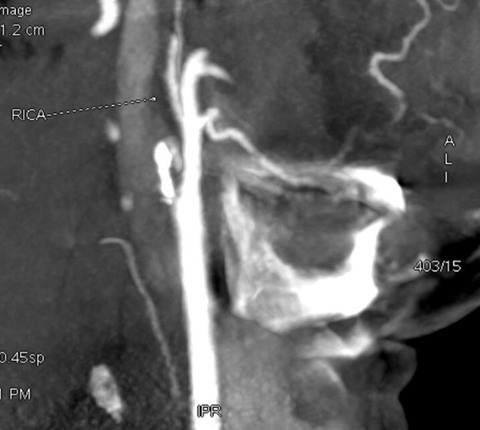CASE REPORTS: Thrombolysis in acute retinal ischemia treated with tenecteplase
Main Article Content
Abstract
Central retinal artery occlusion (CRAO), a type of acute retinal arterial ischemia, analogous to an ocular stroke, is a medical emergency that warrants immediate diagnosis and treatment. CRAO usually presents with sudden, painless, monocular vision loss. Ipsilateral carotid artery disease is an important associated finding in these patients. The primary limitation to effective treatment of CRAO is that patients are rarely seen in the acute stage. Moreover, there are no guidelines for effective treatment. We report a patient with right CRAO whose treatment with intravenous thrombolysis with tenecteplase and anterior chamber paracentesis with ocular massage resulted in a good clinical outcome.
Downloads
Article Details

This work is licensed under a Creative Commons Attribution-NonCommercial-NoDerivatives 4.0 International License.
References
Varma DD, Cugati S, Lee AW, Chen CS. A review of central retinal artery occlusion: clinical presentation and management. Eye (Lond) 2013;27:688-97.
Biousse V, Nahab F, Newman NJ. Management of acute retinal ischemia: follow the guidelines! Ophthalmology 2018;125:1597-1607.
Dumitrascu OM, Newman NJ, Biousse V. Thrombolysis for central retinal artery occlusion in 2020: time is vision. J Neuroophthalmol 2020;40:333-45.
Burgos AM, Saver JL. Evidence that tenecteplase is noninferior to alteplase for acute ischemic stroke: meta-analysis of 5 randomized trials. Stroke 2019;50:2156-62.
Lee A, Chryssidis S, Thoo S, Chen C. Poster abstracts: AS31-039. Eur Stroke J 2017;2(1_suppl):125-26.
Mac Grory B, Schrag M, Biousse V, et al; American Heart Association Stroke Council; Council on Arteriosclerosis, Thrombosis and Vascular Biology; Council on Hypertension; Council on Peripheral Vascular Disease. Management of central retinal artery occlusion: a scientific statement from the American Heart Association [published correction in Stroke 2021;52:e309]. Stroke 2021;52:e282-94.
Schultheiss M, Härtig F, Spitzer MS, et al. Intravenous thrombolysis in acute central retinal artery occlusion—a prospective interventional case series. PLoS One 2018;13:e0198114.
Préterre C, Godeneche G, Vandamme X, et al. Management of acute central retinal artery occlusion: intravenous thrombolysis is feasible and safe. Int J Stroke 2017;12:720-23.
Nedelmann M, Graef M, Weinand F, et al. Retrobulbar spot sign predicts thrombolytic treatment effects and etiology in central retinal artery occlusion. Stroke 2015;46:2322-4.
Hattenbach LO, Kuhli-Hattenbach C, Scharrer I, Baatz H. Intravenous thrombolysis with low-dose recombinant tissue plasminogen activator in central retinal artery occlusion. Am J Ophthalmol 2008;146:700-6.
Kattah JC, Wang DZ, Reddy C. Intravenous recombinant tissue-type plasminogen activator thrombolysis in treatment of central retinal artery occlusion. Arch Ophthalmol 2002;120:1234-6.
Mames RN, Shugar JK, Levy N, Brasington A, Margo CE. Peripheral thrombolytic therapy for central retinal artery occlusion. CRAO Study Group. Arch Ophthalmol 1995;113:1094.
Schumacher M, Schmidt D, Jurklies B, et al. Central retinal artery occlusion: local intra-arterial fibrinolysis versus conservative treatment, a multicenter randomized trial. Ophthalmology 2010;117:1367-75.e1.
Hayreh SS, Zimmerman MB. Central retinal artery occlusion: visual outcome. Am J Ophthalmol 2005;140:376-91.




